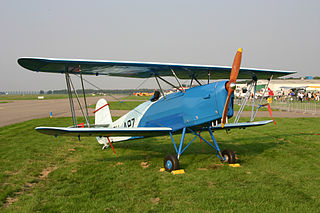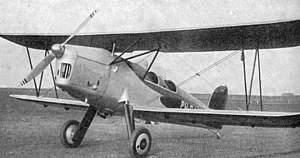
The de Havilland Gipsy Major or Gipsy IIIA is a four-cylinder, air-cooled, inverted inline engine used in a variety of light aircraft produced in the 1930s, including the famous Tiger Moth biplane. Many Gipsy Major engines still power vintage aircraft types.
The Koolhoven F.K.42 was a parasol-wing, two-seat training monoplane manufactured by Koolhoven in the Netherlands. Only one was built.
The Koolhoven F.K.57 was a twin-engined, gull-winged monoplane built in the Netherlands as a personal transport for the Director General of Royal Dutch Shell. Only one was made, flying chiefly in Europe in the year before World War II, but destroyed when Germany invaded the Netherlands in May 1940.

The IAR-22 was a single engine basic trainer built in Romania in about 1934. It was a low-wing monoplane with two seats in tandem and a fixed conventional undercarriage.
The Sopwith Admiralty Types 137 and 138 were a pair of single-engine, two-seat naval biplane floatplanes, built to a British Admiralty order in 1914. They were similar in design, but having a more powerful engine the Type 138 was the larger and heavier. They were used in early torpedo dropping experiments in 1914.

The Hispano-Suiza E-34, later renamed Hispano HS-34, was a Spanish single engine, tandem seat biplane, designed as a basic trainer. Twenty five were ordered by the Aeronáutica Naval, but only five had been completed when the Spanish Civil War intervened.

The Morane-Saulnier MS.341 was a single engine parasol wing training and touring aircraft built in France in the mid-1930s. It had two open cockpits in tandem and was sold to private owners, clubs and the Armée de l'Air.

The Pander E was the first indigenous Dutch training aircraft, used by clubs and also privately owned. A two-seat, single-engine biplane, 17 were built in the Netherlands from 1926 with engines of increasing power.

The Pander P-1 and P-2 were close to-identical single engine Dutch sports aircraft with tandem seats and a parasol wing, first flying in 1929. Only two were built.
The Pander P-3 was a parasol wing, two seat, single engine sports aircraft designed in the Netherlands in the early 1930s. Only one was built.
The Koolhoven F.K.44 was a two-seat, single engine sport monoplane designed and built in the Netherlands in the early 1930s. It was built to order, but only one was completed.
The Koolhoven F.K.45 was an aerobatic biplane built to the requirements of one pilot who flew it at airshows in the mid-1930s. Only one was built.

The Koolhoven F.K.54 was a Dutch single-engine, three-seat touring aircraft with a retractable undercarriage. It flew shortly before the start of World War II and its development was abandoned after its first flight as attention turned to military aircraft.
The NVI F.K.29 was a small Dutch biplane transport, carrying two passengers who boarded after the nose, with its single engine and fuselage, had been swung open. It was intended to link small local fields to main airports.

The NVI F.K.32 was a tandem two-seat biplane training aircraft designed and built in the Netherlands in the mid-1920s. It did not go into service.

The NVI F.K.35 or Koolhoven F.K.35 was a two-seat fighter aircraft built in the Netherlands during 1926. It was completed and exhibited but, through a combination of ground accident and financial problems, never flown.

The Lambach HL.II was a single seat aerobatic biplane designed and built in the Netherlands to provide Dutch pilots in a local, annual competition with their own machine. It proved no match for contemporary Germany aircraft.
The Hollandsche Vliegtuigenfabriek Avia was a two-seat biplane, designed and displayed in the Netherlands in 1918. It was advertised as a fighter or as a post and passenger aircraft. Its first flight has not been confirmed.
The Kondor D 7 was a prototype German single seat biplane fighter built over the winter of 1917-18. It was not a success and its development was soon abandoned.
The Curtiss-Reid Courier was designed in Canada in 1931 as a specialist, non-passenger carrying, mailplane capable of maintaining services in Canada's hard winters. The 1930s depression led to the end of government subsidised airmail contracts and only one prototype flew. It was lost in 1933 during preparations for a private, long distance flight.










